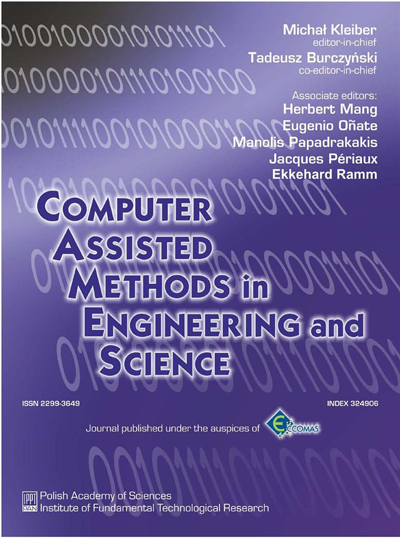Numerical investigations of the convergence of a remeshing algorithm on an example of subsonic flow
Abstract
The main goal of the paper is to analyze convergence of a remeshing scheme evaluated by the author [8] on the example of a potential flow around a profile. It is assumed that flow is stationary, irrotational, inviscid and compressible. The problem is led to solving nonlinear differential equation with additional nonlinear algebraic equation representing the so called Kutta-Joukovsky condition. For adaptation a remeshing scheme is applied. For every adaptation step mesh is generated using grid generator [7], which generates meshes with mesh size function. The mesh size function is modified at every adaptation step by nodal values of the error indicator interpolation. The nonlinear algebraic system of equations obtained from discretizing of the problem, is solved by the application of the Newton-Raphson method.
Keywords
finite element method, fluid mechanics, grid generation, remeshing, Kutta-Joukovsky condition,References
[1] H. Berger, G. Warnecke, W.L. Wendland. Analysis of a FEM/BEM transonic flow computations. Universitaet Stuttgart, Mathematisches Institut A, Raport, 1993.[2] P.G. Ciarlet. The Finite Element Method for Elliptic Problems. North-Holland Publishing Company, Amsterdam, New York-Oxford, Studies in Mathematics and its Application, 1978.
[3] L. Demkowicz, J.T. Oden, W. Rachowicz, O. Hardy. Towards a universal h-p adaptive finite element strategy, Part 1: constrained approximation and data structure, Comp. Meth. Appl. Mech. Engrg., 77: 79–112, 1989.
[4] P. Dierckx. Curve and Surface Fitting with Splines. Oxford Science Publications, Clarendon Press, Oxford, 1995.
[5] R. Glowinski, T.W. Pan, T.I. Hesla, D.D. Joseph, J. Periaux. A distributed Lagrange multipliers/frictious domain method for the simulation of flow around moving rigid bodies: application to particular flow. Comp. Meth. Appl. Mech. Engrg., 184: 241–267, 2000.
[6] O.P. Jacquotte, J.L. Godard. Multidomain solution algorithm for potential flow simulation. Comp. Meth. Appl. Mech. Engrg., No. 1–2, 1–19, 1994.
[7] J. Kucwaj. The Modelling and Triangulation of Geometrically Complicated Plane Domains and some Applications to Fluid Mechanics. Journal of Theoretical and Applied Mechanics, 35: 2, 369–392, 1997.
[8] J. Kucwaj. The Algorithm of Adaptation by Using Graded Meshes Generator. Computer Assisted Mechanics and Engineering Sciences, 7: 615–624, 2000.
[9] S.H. Lo. Finite element mesh generation and adaptive meshing. Progress in Structural Engineering and Materials, 4: 381–399, 2002.
[10] J.T. Oden. h-p adaptive finite element methods for compressible and incompressible flows. Computer Syst. in Engrg., 1: 2–4, 523–534, 1990.
[11] A. Safjan, L. Demkowicz, D.P. Young. Compressible flow hp-Adaptivity and Kutta-Joukovsky condition, October 2006, The Boeing Company Project.
[12] Desheng Wang, Oubay Hassan, Kenneth Morgan, Nigel Weatherill. Enhanced remeshing from STL files with applications to surface grid generation. Comm. in Num. Meth. in Engrg., 65: 734–751, 2006.




